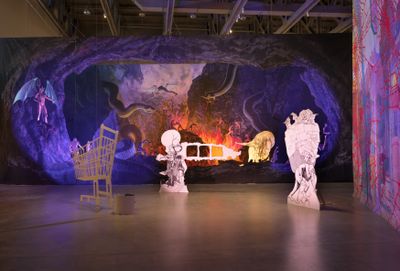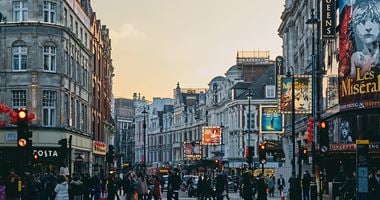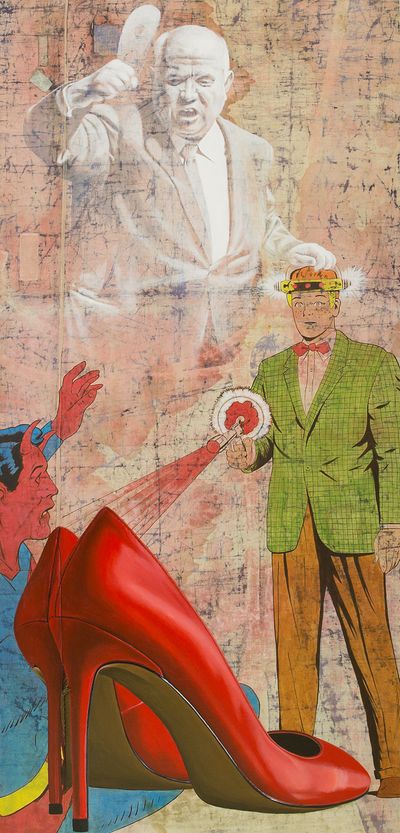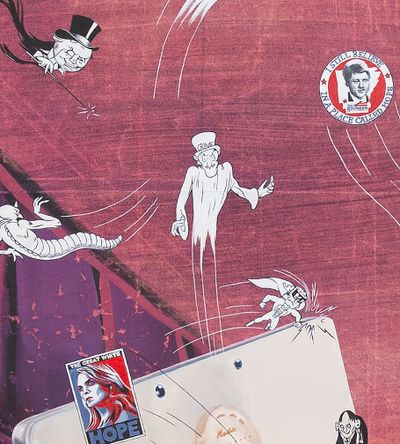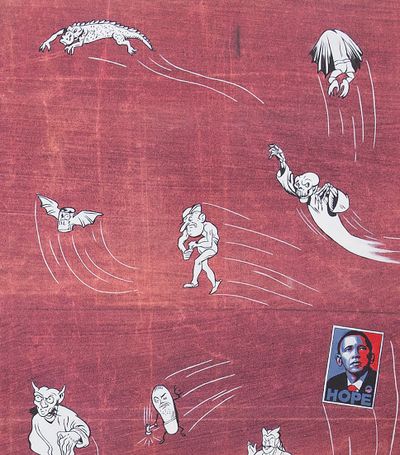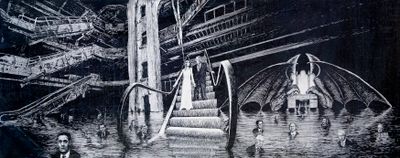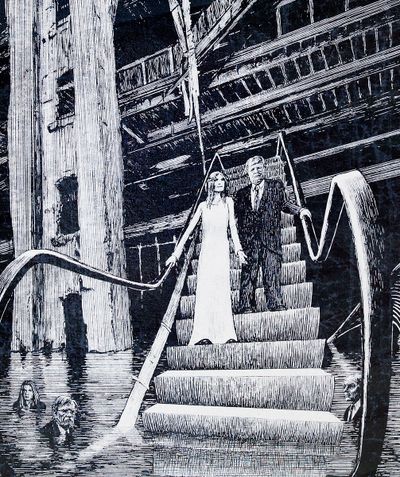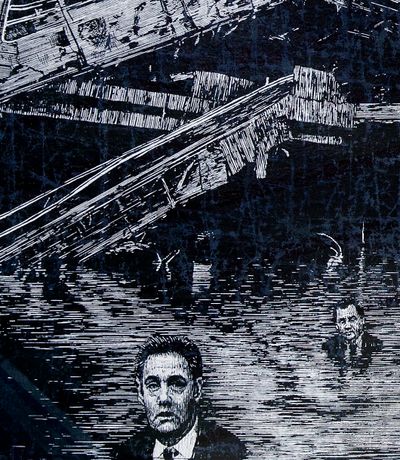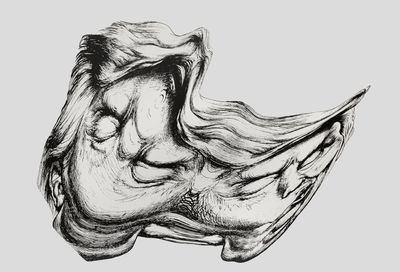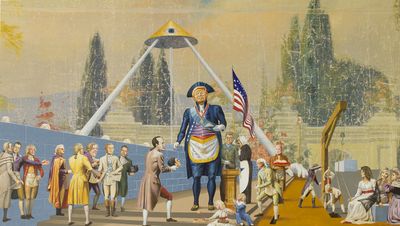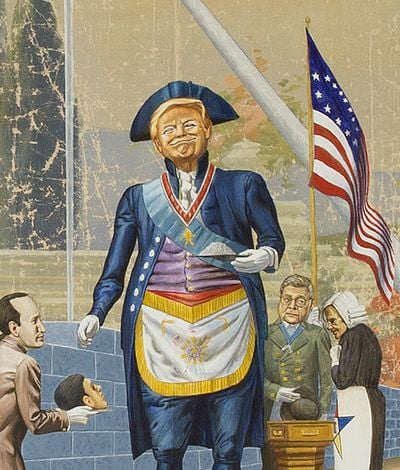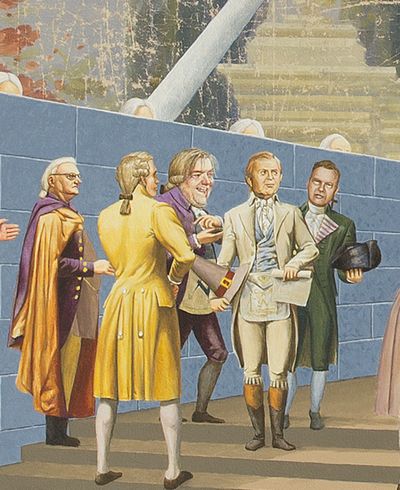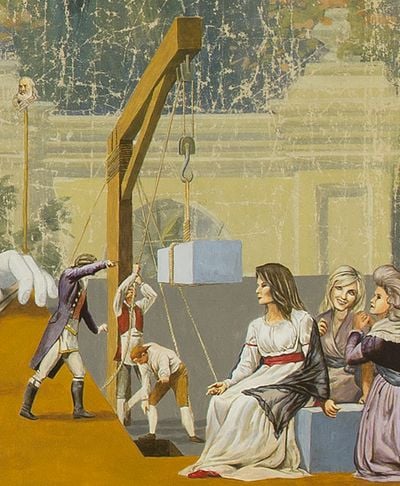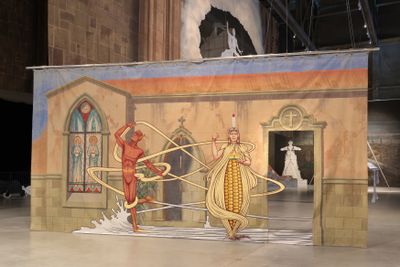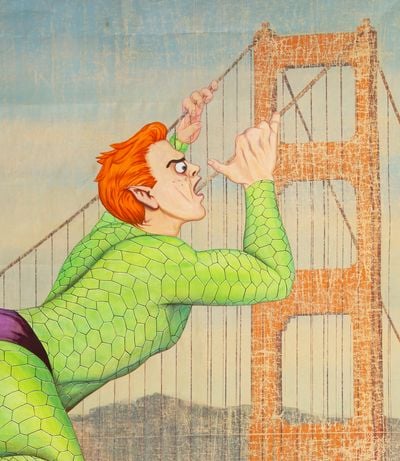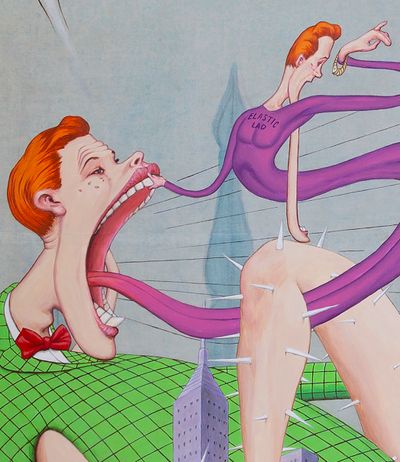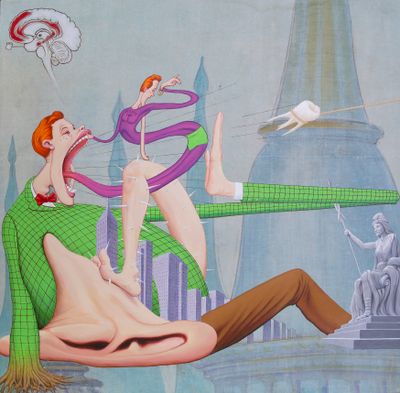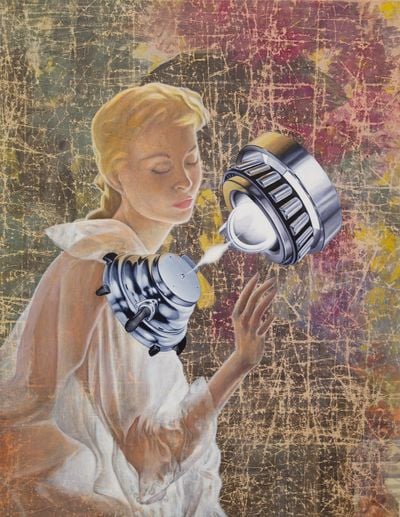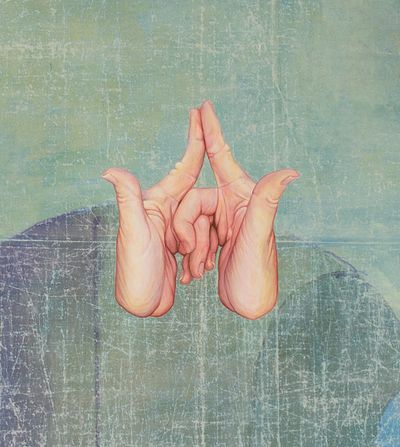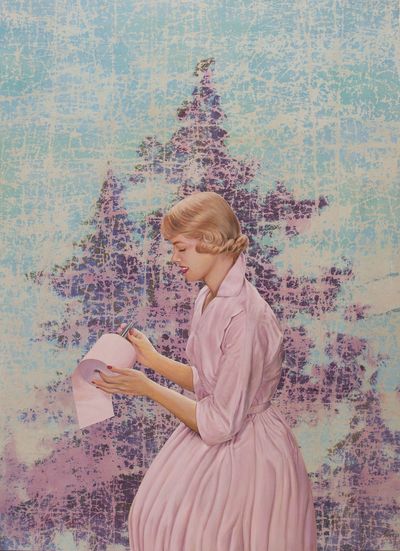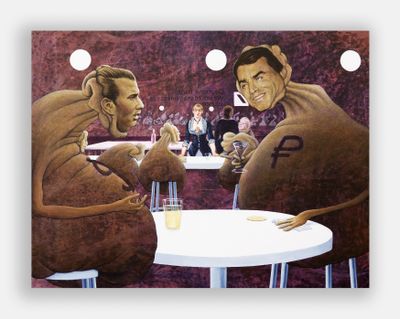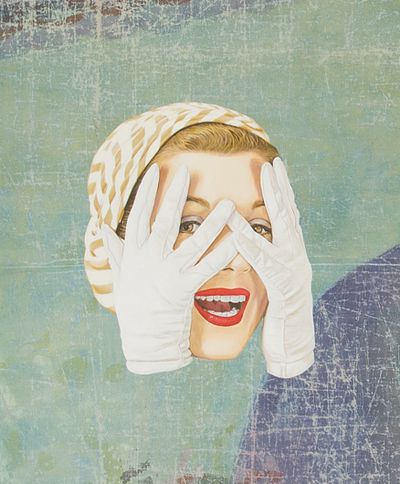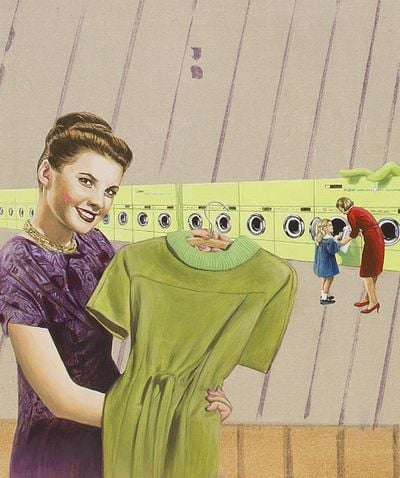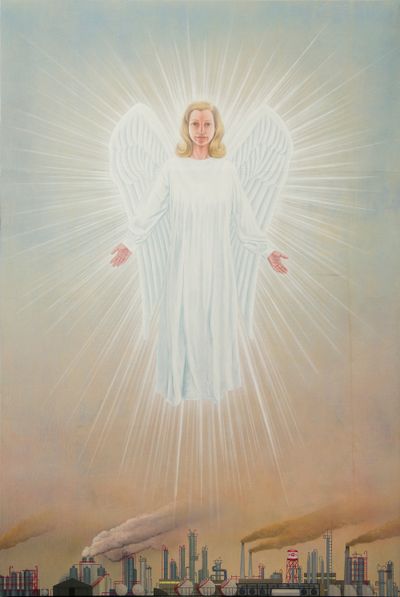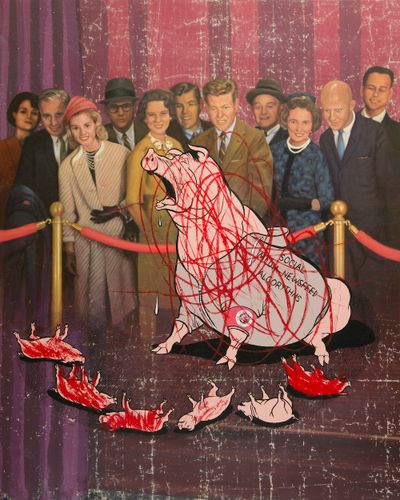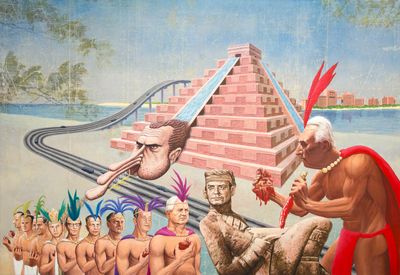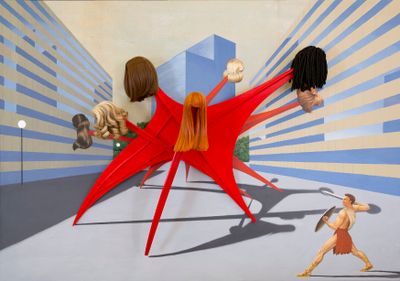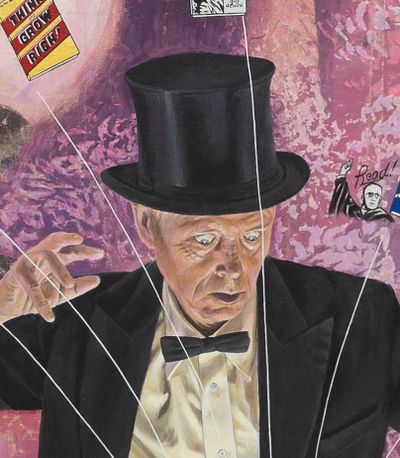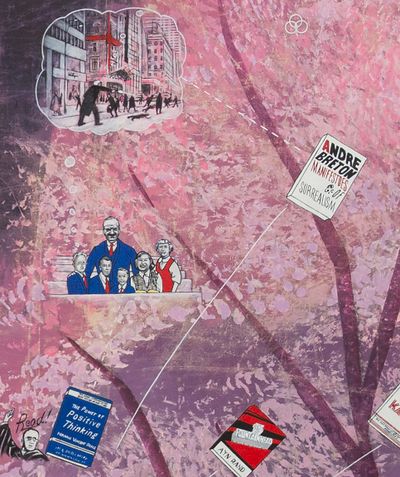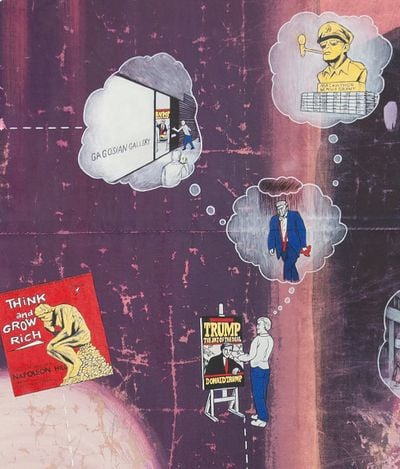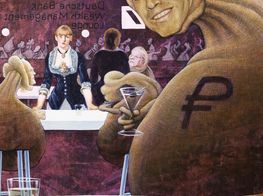'We'll see what the hell happens': Jim Shaw on Politics and Pop Culture in the U.S.
In Partnership with Simon Lee Gallery
Jim Shaw. Photo: LeeAnn Nickel.
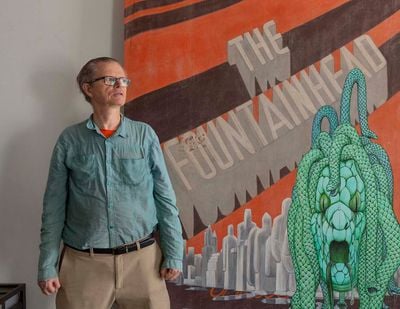
Jim Shaw. Photo: LeeAnn Nickel.
On view at Simon Lee Gallery in London, Jim Shaw's exhibition Hope Against Hope (20 October 2020–16 January 2021) presents a series of the artist's latest paintings that mine American contemporary culture.
Through sources ranging from thrift store paintings, rock albums, pulp novels, and newspaper cut-outs, Shaw looks to the turmoil of the current American socio-political arena, in the lead-up to the presidential U.S. election, as inspiration. In one painting, The Master Mason (2020), Donald Trump takes the place of George Washington, who was a Master Mason—one of 14 U.S. presidents to be associated with the fraternal organisation.
In reference to Trump's plan to 'build a wall', Shaw explains that building walls is central to Freemasonry as a secret society—a theme that reappeared in 2017 in The Wig Museum, at the now closed Marciano Art Foundation in Los Angeles (25 May–23 December 2017), where Shaw responded to the site of the former Scottish Rite Masonic Temple on Wilshire Boulevard. Activating the space through theatre backdrops depicting struggles between good and evil, Shaw explored themes of repression, secrecy, and authority.
Since the early 2000s, Shaw has purchased backdrops from theatre companies to use in his work. In 2008, Shaw accumulated these to be used for a prog-rock opera titled The Rinse Cycle, riffing off Wagner's Ring cycle of music dramas. The opera is yet to be realised, but its title was attributed to Shaw's exhibition at BALTIC Centre for Contemporary Art in Gateshead (9 November 2012–17 February 2013). The exhibition spanned Shaw's trajectory as an artist beginning at the University of Michigan, where he formed the punk noise and experimental band Destroy All Monsters with fellow students Mike Kelley and Lynn Rovner.
American counterculture continues to appear throughout Shaw's work, revealing the nation's defining socio-political values. In this conversation, which was transcribed from a talk with Lydia Yee, chief curator at London's Whitechapel Gallery, held on 28 October, Shaw discusses his latest solo exhibition, and his thoughts on the political and pop-cultural themes that come together in his work.
LYI want to start by asking you about the title of this exhibition, Hope Against Hope. Where does that title come from?
JSI read this book on Greek myths, which suggested that when the gods cursed the human world with Pandora—because it was an all-male society up to that point—of the evils that were contained in Pandora's box, hope was the last to emerge. To the ancient Greeks, hope was actually negative, deceiving—like a carrot that makes humans toil endlessly for a hopeless ending.
I'm not sure where the phrase itself, 'hope against hope', comes from, because it's kind of a weird term. But as we grasp at straws trying to find some way out of this postmodern decline, maybe we are all struggling for some kind of hope—for some better world.
LYAre there any political connotations to that phrase? It was something used by Bill Clinton.
JSYes, he used the term, 'I still believe in a place called Hope', because he was born in a town called Hope. But he was raised in a hotbed of gamblers and organised crime figures—a different town. In one painting, Pandora's Box (2020), there's a couple of major uses of hope, specifically the famous Obama poster.
You know, as much as I love Obama, the administration failed, and as much as I hate Trump, the real bad guy here is the head of the Senate, just slamming down anything positive.
I realised after Covid had crippled the economy and the government somehow managed to pass all these bills that would hand money directly to people, that if Hillary actually had been able to take her place as President, that wouldn't have happened because the Republicans would have stopped her from pushing any social spending on the basis of it being fiscally irresponsible.
...if I was a better people person, maybe I would have engaged in one to one politics.
Obama was pretty much trapped. He managed to get one thing done in his first two years, and then he was stymied, so then he struck out. He began to use all these presidential findings. And that's exactly what Trump has been utilising to get through anything he couldn't get through Congress. A 'fuck you' to all the libs and Obama.
It's kind of hope-less. But at the same time, you know in a few short days, maybe this will all be different...
LYWe're just a week away from the U.S. presidential election. A few of your paintings here, Donald and Melania Trump descending the escalator into the 9th circle of hell reserved for traitors frozen in a sea of ice (2020) and The Master Mason (2020) feature images of Trump and his enabling sycophants, deemed traitors and cast into the ninth circle of hell.
Are you concerned with the fast approaching expiry date for number 45? Will that make these paintings seem irrelevant in a week's time?
JSI pray they will be irrelevant! You know, I hope the system works this time. That's why I really wanted the show to open before the election, because if he lost, they'd already be irrelevant. At least now they have some relevance, but that's a big if he loses.
I used to say that Trump wasn't the worst president because at least he hasn't started a war to get re-elected like George W. Bush, or totally subverted the Constitution like Ronald Reagan and like Bush's father did with Iran-Contra. But if he starts a civil war, which he seems to be doing, that's just as bad. Or maybe not, as all the sins will land within the borders of America instead of far afield.
In the case of the black and white painting of hell, Donald and Melania Trump descending an escalator into the ninth circle of hell reserved for traitors frozen in a sea of ice, those traitors are people who've already sort of jumped ship and spoken out against Trump.
LYThe central figures in the painting are Trump and Melania. And they're on an escalator descending. I think that's a reference to the launch of Trump's campaign in 2015. But here you have them descending into an icy or frozen lake. It's quite an apocalyptic landscape. The background is from a theatre backdrop, correct?
JSYes. it's printed in white on top of the theatre backdrop, so you see a certain amount of the backdrop content, but most of what you're seeing is this sort of fake Gustave Doré etching of hell inspired by Doré's etching of Dante's Ninth Circle of Hell.
The set and figures are essentially based on Doré's, but instead of having a head, the devil is a vanity with three mirrors, because he's typically seen to have had three heads in hell. Instead of a cavern, the hellscape is a defunct, flooded mall in Thailand.
I like the image of the shopping mall as hell, which was sort of the central case of The Wig Museum exhibition and this is a reiteration of that notion.
LYSo the image of the shopping mall is silk-screened onto the theatre backdrop, and other figures are hand-painted.
JSThey're a mixture. Everything has been silkscreened that's in white or off-white. But some things needed fixing up, like there's a division line between the two different screens that had to be painted in. Then the likenesses of the different figures, like 'Mad Dog' Mattis and Omarosa Manigault Newman, had to be boosted because they didn't exactly look like who they were, even in the original drawing, which is about half-scale.
I like that cartoons utilise visual puns, because to me, the subconscious does that in our dreams, or at least in my dreams.
LYIt's striking because this is also the only monochromatic work in the exhibition, and it has quite a different feel to a lot of the other works. This work looks like it could have been almost plucked out of the 19th century.
JSWell, it's based on Doré, so it's definitely a 19th-century related work. Most works are related to pop cultural references from the 1950s and 60s in the show. But this is a pop cultural reference to those of the late 1880s, a pre-copyright era. My interest in engraving probably started with Max Ernst's re-collaging of them, when I was a teenager.
LYDo you see this painting as a contemporary political cartoon or commentary, or is it more like a history painting?
JSI think history painting. If you look at the history of political cartooning, a lot of political cartoons from the 1890s were based on history paintings—they were filled with all sorts of contemporary allusions to things. The same could be said of political cartoons of the 1950s.
I like that cartoons utilise visual puns, because to me, the subconscious does that in our dreams, or at least in my dreams. But puns have kind of gone out of favour as a form of humour. You know the Greeks elevated them, and James Joyce utilised nothing but puns in Finnegans Wake (1939).
To me, visual punning is important because it deflects some of the media. I mean, these aren't exactly protest posters about a massacre that just occurred. They're indirect and they're trying to talk through a slightly longer lens, a longer time frame, than the immediate present.
I've been feeding some of my images onto the internet because I just don't know how to become a meme. I'm too old for that. But I would love for things to be picked up as memes. Recently I saw a version of Saturn eating his own children, but it was Mitch McConnell—that is not dissimilar to one of my paintings, which is a version of the old 'I Want You for the U.S. Army' poster where Uncle Sam merges with Saturn.
The internet is kind of like the contemporary version of leafleting, like posters going online. Unfortunately, the left wing is being outflanked by the extreme right in that regard.
LYI wanted to ask about a related work, The Master Mason. It's modelled after one of three murals in The George Washington Masonic National Memorial, Alexandria, Virginia, painted in 1955 by Allyn Cox, depicting the ceremony of George Washington laying the cornerstone of the U.S. Capitol in 1793.
The first U.S. president was a Master Mason, and he was also known for his honesty, which is perhaps exemplified best by the parable or the story where he confessed to his father that he cut down his prized cherry tree.
What is going on in this painting? And why have you chosen to replace Washington with perhaps the most dishonest president of all time?
JSWell, 'building a wall' was the catch phrase for Trump's career as a politician and building walls is sort of central to Freemasonry. At least in its inception, just like almost everything in the history of the world up till sometime in the 20th century, Freemasonry was a highly racist institution and I'm sure many major plantation owners were masons themselves.
I'm just making assumptions, I haven't read a detailed history of Washington, but one fact stood out that he was purported to be the richest man in America at the time he was alive, and I don't think you get to be the richest man in 1776 without some kind of land grant from the king in your family's history. If he had a land grant, then he might have been one of those people that could use slaves.
One of the characters in my painting, a very small figure, is actually just Albert Pike's head on a pike—he was the author of Morals and Dogma of the Ancient and Accepted Scottish Rite of Freemasonry (1871), an American publication. He was a Confederate general and purported by some to be one of the founders of the KKK. I don't know if that's backed up by real fact. But, hey, I saw it online! Well actually on original cable. So that seemed to make sense.
Also, there's an old political cartoon from the 1890s against the moneyed fat cats on Wall Street that has this famous Wall Street statue basically repurposed as this greedy, potbellied character. That's sort of the basis for the Donald Trump figure, slightly larger than the original Washington, who is no bigger than anybody else. But in this version, he's elevated to a larger status, with everybody quaking under him.
In the figures of Attorney General Barr and Kellyanne Conway, there is also a reference to The Angelus (1857–1859), an oil painting by French painter Jean-François Millet that depicts two peasants bowing in a field over a basket of potatoes to say a prayer, the Angelus, that together with the ringing of the bell from the church on the horizon marks the end of a day's work.
I placed this little child-sized coffin there because of Dalí's insistence that instead of praying over food, they're praying over the child. I just couldn't help but make that allusion. Salvador Dalí saw a print of The Angelus in his school and insisted that this was a funeral scene, not a prayer ritual, and that the couple were portrayed praying and mourning over their dead infant.
LYI wanted to return to your use of theatre backdrops. The ones in this exhibition are obviously not the ones that you used for your show at the Marciano Art Foundation. I understand you actually purchased these theatre backdrops?
JSYes. The hellscape area at the Marciano Art Foundation utilised actual Masonic ritual backdrops, which I amended with black and white cut-outs, so I didn't sully the originals, but there were other pieces at Marciano that were on backdrops. There was this sort of world of superheroes in black and white over an image of the Mississippi River. And another one that was called The Rinse Cycle (2012), which is also the name of my probably never-to-be-finished prog-rock opera, which shows a field of late 1950s, early 60s women's hairdos over the interior of a washing machine as rendered by a speed-addicted illustrator in the late 1960s.
Or at least that was my interpretation of it. Scoping out the information for that painting got me interested in hair as an aesthetic, which led to the works in The Wig Museum. But that also came from a dream I had about a tourist trap in Tijuana.
LYI know you've been purchasing backdrops from companies that supply theatre sets or theatre backdrops for local repertory theatre. And once they're no longer in good condition, I believe they are willing to sell them to you. Is that correct?
JSThat's correct. Originally my wife, Marnie Weber, was looking for a backdrop for one of her videos way back in the early 2000s. We found a place with a section to buy used backdrops, and when I started looking at them, I thought, oh God, I'm gonna have to work with these things.
Usually I have the idea and I think, oh, I'll do this and that. And then occasionally there's one where the idea and the backdrop just suddenly coexist and co-align.
I started working at the full scale so that if the backdrop was, say, 17 by 90 feet, I would come up with a composition that encompassed the entire scale of that piece. And for many years of doing these things and employing a large crew and renting a large space to be able to do them, I thought, I can't handle it anymore. I'm accruing a lot of stuff that might end up in my storage at great expense. So I started working with little chunks of them taken out of context.
LYHow do you marry the composition that you want to paint with the found backdrops?
JSWell, take The Golden Gate (2020)—that's the smallest part of the actual Golden Gate backdrop. About 60-feet high... it's a pretty damn large painting.
That backdrop inspired the use of the monstrous Jimmy Olsen turtle man, which was also inspired by the cover of a Jimmy Olsen comic, which was in turn inspired by—well, the authors and illustrators of the comic stole the idea—from a pulp sci-fi comic. They created a storyline in which Jimmy Olsen somehow turned into a giant, aggressive, destructive turtle monster attacking bridges and battleships.
Usually I have the idea and I think, oh, I'll do this and that. And then occasionally there's one where the idea and the backdrop just suddenly coexist and co-align.
LYJimmy Olsen is not your archetypal superhero—could you tell us a little bit about him and what his special powers are?
JSJimmy Olsen was kind of like the equivalent of Batman's sidekick, Robin. He became Superman's pal and Lois Lane became Superman's girlfriend, giving them more titles to sell.
You know, he was invented as a character for them to be a little closer to their age of the actual readers, in case they couldn't identify with a man but might identify with a teenage boy. When Jimmy Olsen got his own comics, they didn't know what to do with him, but at the same time, the editor of all those DC Comics basically wanted the cover image to be a sales point to these ten-year-old boys. So Jimmy Olsen just became this bucket into which writers could pour any weird thing they wanted.
The guys who created Superman were pulp writer wannabes. And so they sort of kluged together, a surrealist mythology based on selling things to ten-year-old boys. And that includes a lot of innocent sexuality that becomes a little less innocent when it gets turned into alive action movie with steroidally enhanced male actors duking it out.
I also would like to mention Raymond Roussel, a French poet, novelist, playwright, musician, and chess enthusiast. Through his novels, poems, and plays, he exerted a profound influence on certain groups within 20th-century French literature, including the Surrealists, Oulipo, and the authors of the Nouveau Roman books, like Impressions of Africa (1909).
I was reading that the secret behind the weirdness of Roussel's stories, besides the fact that he wanted to be like the new Jules Verne, was that either the entire story or each chapter of the story was the same exact sentence with one letter changed, which would change the meaning of the entire sentence. His goal was to construct a storyline that sort of filled in between those two things.
I like the idea of projecting the image of the artist as an absurdist version of a Greek hero.
In the case of DC Comics, their goal was to take an arresting image and then create a storyline around it, so they got the weirdest covers and stories focused on Jimmy Olsen. What made them Roussel-like was that the plots that tethered these bizarre cover images inevitably had to bend over backwards to come up with some rational, or scientific reasoning that explained weird behaviours the covers promised.
Another thing about Jimmy Olsen, to me, is that in brain chemistry, the part of your brain that is switched off when you're taking psychedelic mushrooms or other psychedelics is like the core of your character. In other words, it's where all of your socialisation is centred, which barely exists in a five-year-old, but is ensconced pretty heavily by the time you're 27.
There's a reason why you can't rent a car until you're 25, because your brain's still pretty amorphous, and the way I see it, Jimmy Olsen's brain is kind of in that state. So in the painting Jimmie Olsen vs. the Goddess of Reason (2020), I kind of inserted this into an empty space.
I inserted this rather odd illustration of that chunk of the brain in the form of a caricature of Popeye, sort of as a brain. And it was partly just because it looked like Popeye and also because of Popeye's catchphrase, 'I am what I am. I'm Popeye. The sailor man.'
In a weird way, this seemed to echo that form of the brain, and the reason why those drugs are useful in treating depression may relate to the fact that when you turn that rigid character off for a period of time, it's possible to overcome it. So Jimmy Olsen can become anything at any time.
LYYour first job out of CalArts was working in special effects. Did this prepare you for working at this scale, involving multiple people, and imagining stories that might go into a video or an animation? Do you see a connection to working in this more theatrical way?
JSWell, I have attempted occasionally to just kind of improvise these things and it hasn't worked out. But working in special effects got me into the habit of prepping things, doing them very carefully, in a systematic manner. That's the biggest thing I learned.
I don't want to be dominated by consumerism, which has overtaken our economy to an insane level.
My idea was that I would always have something to fall back on. I could go back to working in special effects if things in art failed, but I hadn't counted on being too old and unschooled in computers and special effects to compete after a few years out of the field.
The original generation of people who worked in special effects didn't have a background in computers. They were people with degrees in arts more generally, rather than specific to computer animation, because that field hadn't yet been invented when we were at college.
A lot of people that I worked with ended up getting Academy Awards later, but mostly we worked on TV commercials, although the private, most auspicious project I worked on was Terrence Malik's The Tree of Life (2011), which was in preproduction in the late seventies before the head of Paramount became the head of Disney. Then it sat around underdeveloped for 35 years.
That was a weird period for me, but I'm sort of glad I could go through the early eighties with a mild coke addiction, which was very normal in the effects industry, so that I wouldn't be wasting my time and money as an artist. That was a good choice.
LYYou collect Christian objects and ephemera and you've even come up with your own fictional religion. A few of the paintings in this exhibition carry a religious subtext.
JSI mean, essentially, those are images from 1950s advertisements that turn the housewife into the Madonna in adoration of, in one case, a roll of toilet paper.
I am not a Christian, but I have some Christian morals in me. I see a shopping mall as a vision, but I'm not a consumer. But I don't want to be dominated by consumerism, which has overtaken our economy to an insane level.
LYYou appear in one of these paintings, The Beckoning (2020), as a man in a top hat wearing a tailcoat and white gloves. He's drawing the viewer into a mid-20th century New York skyline. Is this figure leading us on a path of sin or salvation? Do you consider this a self-portrait?
JSMy assistant, Daniel Hope, had been the top hat man, but the top hat and tails I recently bought fit me rather than him, so I just thought I might as well be the model this time. There were a variety of poses. I would have used Daniel. He's very good at doing faces and poses, and I'm also okay. I'm not a bad model.
As far as meaning goes, it's pretty amorphous. But originally, the dark part of the figure was going to be sort of the sunrise German Expressionist vision of the city at night as a place of sin—like Times Square before it became a Disney bonanza, but it would have been confusing.
The figure of the top hat man usually stands in for the wealthy guy carrying a sack full of money. In this case, he's more like the wealthy guy carrying an offering—your credit card. Maybe it can save your soul.
I've done a few of these things where the painting is like this mirror or another world to be entered. There's actually a very weird British compilation film in which a man is enticed to enter a painting. There's a maniac inside who likes to kill people and they need matches because the one person in the painting thinks it's not properly balanced anymore. I can't remember the name of the movie, but it's a pretty fascinating concept.
LYMany of the women in the paintings seem to be from a different time. They often have the appearance of this suburban housewife out of a 1950s advert for a household appliance or for other domestic goods. What do these women have to do with the present?
JSYou know, we can all look at these images and agree they are from an antique era. There is no iconic, liberated woman imagery.
This guy that I went to CalArts with, he was a friend who owned the O-Cedar mop company, and they had this commercial where a group of women were picketing saying, 'We want the power strip, we want the power strip'—an O-Cedar product. And then this harried shop owner said, 'Ladies, they just came in!' and these protesting women all scream and ran inside the store. He wanted to talk about using special effects for another ad, when I asked about that ad, he said, 'We don't know why, but it sells a lot of mops!'
I've done a few of these things where the painting is like this mirror or another world to be entered.
It was like the confluence of the stereotype of protesting women and consumerism. Maybe that'll find its place in my work someday when the men are pretty much typed in the past as well. It's also the past of two artists who were very influential on me, James Rosenquist and R. Crumb, who did a number of collage pieces using advertised months from the late 1940s, which aren't well known.
And of course, Rosenquist being a billboard artist who is adept at all that stuff. That's the whole influence of pop on my work, that I would be attracted to these things.
I was just watching an interview with Kim Kardashian where she explains that she could make more money mentioning a product on Instagram than she could for an entire season of reality TV. That is fucking phenomenal. That's something I cannot possibly imagine needing to turn into a painting.
At the Marciano Foundation openings, one of the first things that they immediately asked you was what kind of influencer you are, which I am not.
LYI know you grew up in Midland, Michigan—the home of the plastics, chemicals, and agricultural products manufacturing company, Dow. I believe your father worked for Dow. But you also mentioned that some of the first artists you knew worked for Dow.
JSWell, definitely one. I didn't actually know him until later, but he did these very elaborate things that would involve multiple layers of clear or coloured plastics. And some of them had all kinds of allusions to greater ideas.
The son of the founder of Dow was a pretty great Frank Lloyd Wright acolyte named Alden B. Dow. And so the town was full of really great domestic architecture from the thirties and forties such as churches and office buildings. And then some less endearing stuff, like all our schools and office buildings.
Two artists who lived in Midland were Charles Reed and Larry Butcher. Butcher was a student art teacher when I was in ninth grade. He was an adult figure with a beard who made interesting paintings. Maybe the first adult who gave me the idea I could be an artist.
At one point, a decade or so ago, I said to him, 'Wow, you know, you could just sell the shaped canvases, and they'd be very interesting.' And he said, 'Yeah, but now I'm going to do what I gotta do.' I said the same thing to Robert Williams when I saw one of his paintings at a formative, line art stage, and his answer was the same.
We're all cursed with this need to complete things, especially when you're an anal-retentive artist. Sometimes you'd be better off just leaving some stuff blank.
LYI think it's fascinating that at the heart of this corporate culture, there could also be this kind of countercultural impulse. That seems to have been quite formative for you.
JSWell, also there was a guy who may or may not have ever lived in Midland, Alexander Shulgin, who was the pre-eminent psychedelic chemist and was an employee of Dow.
There was some guy who lived near my friend who lived in a very swell Dow house on the golf course, the rich part of town. His father was a surgeon—that was back when doctors got paid more than anybody else. And he said, 'Oh, I met this great old hippie guy who lives near me. He invented STP!' It could have been a different psychedelic chemist.
'Better living through chemistry' was probably a corporate slogan for all chemical companies. But if you're in a small town that has the second highest concentration of people with PhDs in the country, you're going to have a lot of people on the autism spectrum as students in school. And I think that's a definite aspect of this kind of countercultural impulse.
You know, the having ideas is the best part of being an artist—it's like the manic element. The execution, the creating of the art, is the depression.
It was also like a very active John Birch Society. And there is now what used to be a five-and-dime store and is now a very influential think tank called the Mackinac Institute. This was the only county in Michigan that voted for Barry Goldwater in 1964. It's an odd place.
I used to buy comic books at Rexall Drugstore that had a mysterious lending library with books by Ayn Rand and other conservative thinkers, near the back door to where you tested your vacuum bulbs for your TV and radio.
LYI also wanted to turn to the painting One Percent for Art (2020), which depicts a red Calder-esque sculpture in a corporate plaza. The sculpture is actually three dimensional, created with wood on the muslin, which I hadn't picked up initially when I saw this in reproduction, as are the synthetic doll's wigs that are hanging from it.
I know you mentioned puns earlier. One Percent for Art is a type of programme in which cities often take one percent from the construction budget of municipal projects to put to art. But you're obviously playing off of that phrase, the one percent, which is usually the group of people who are able to buy art.
Could you talk about this work?
JSI like to have some things that are a little gimmicky now and then, and I've been entranced by wigs—so the idea of using American Girl doll wigs, slightly truncated so that they would fit the scale, I thought was interesting.
Clearly it was inspired by the term 'one percent for art', which prototypically was a red metal sculpture, whether it was a Calder or some other modernist. Red was for some reason the go-to colour for these large civic sculptures. That's how sculptors made a living in the 1970s, pretty much.
The figure of the Greek hero—you know, the hero Hercules trying to kill the Hydra, but the Hydra cannot be killed—is sort of the artist's idea of themselves. I like the idea of projecting the image of the artist as an absurdist version of a Greek hero.
Yet the artist can't really function without the collector. We've gotten ourselves into a situation where prices are so high that the collectors of my early career have been superseded by some entirely different class of collectors. People who used to have inherited wealth have been superseded by people who come from where the wealth comes... from God knows where.
LYI want to talk about magical thinking. In another painting, Magical Thinking (2020), you appear as a magician conjuring up things from the past like Breton's surrealist manifesto, Hitler's Mein Kampf, but also self-help titles. Then, there is this artist painting the cover of Trump's The Art of the Deal. Can you talk about this scenario?
JSWell, it's about magical thinking. And the thing about magical thinking is sometimes it works. You know, Trump's presidency is an example of magical thinking working. The Trump family went to the church of Norman Vincent Peale—the author of The Power of Positive Thinking (1952).
His first marriage took place in Peale's church. Magical thinking is a philosophy that you should just think nothing but positive thoughts about everything, and everything will come to you. I'm from the other side of the tracks. I think nothing but negative thoughts about myself.
In the case of the artist in this, he's engaging in a sort of postmodern wishful thinking that his version of Trump's The Art of the Deal is somehow taking down Trump himself, humiliating him. And then maybe he'll become a MacArthur Fellow and have a show at Gagosian. But in fact, if anything's going to happen, it's going to be that Jared Kushner and Ivanka Trump buy the art and he gets a piece of the action.
Then, I've got a little bit of Trump as being influenced absurdly by André Breton's statement about the most surrealist action being shooting into a crowd at random, relating to his statement about how his people would vote for him even if he shot people on Fifth Avenue.
All the books have influenced thought, and they are all similarly magical-thinking oriented. On the far side it's a combination of Aleister Crowley's The Book of the Law (1904) and the Smithsonian collection of folk music, which was put together by an alchemist magician, Harry Smith, who was a West Coast filmmaker, magician, bohemian, and eccentric.
Around 1940, Smith developed a hobby of collecting old 78s—blues, jazz, country, Cajun, and gospel records. He said, 'When you change the music, you change the society'. So that's part of what led to the blues revival. And part of what led to Led Zeppelin, but so is the influence of Aleister Crowley, to possibly dark ends. To me, in some ways, Jimmy Page is a better magician than Crowley.
LYI certainly hope magical thinking brings about positive results next Tuesday.
JSWe'll see what the hell happens. You know, the having ideas is the best part of being an artist—it's like the manic element. The execution, the creating of the art, is the depression. But it's depression as a blanket that comforts you. There's no stress involved. You're really just getting a dopamine rush from finding all of these visual rhymes and putting them together.
It's kind of sad that it comes down to stimulating dopamine receptors, but I guess I'll keep making art as long as I can, because I'm not good at doing much else. But if I was a better people person, maybe I would have engaged in one to one politics.
My sister works on a ground level knocking on doors for the Democrats in different states. That's where the real work happens.—[O]




